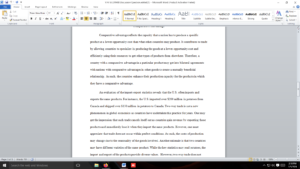Economic Considerations in International Trade
Let’s find import and export data to inform this week’s discussion. While there are many excellent online sources of trade data, please use the Department of Commerce report, U.S. Goods Trade: Imports & Exports by Related-Parties 2016. Here’s a screenshot showing step-by-step how to get data. Select any product you would like to discuss:
My query on Potatoes (NAICS code 111211) gives the following import/export data:
KFirstly, discuss some interesting statistics you found for your product. For me, I find it interesting that Canada is the number 1 source for potatoes imported into the United States. In 2016, we imported over $200 million in potatoes from Canada. Maybe even more interesting is that the number 2 country is Jamaica with over $21 million in potatoes imported. I don’t know enough about the potato market to know what varieties of potatoes we might get from Jamaica. In your post, please share any additional knowledge you have about your product that may be informative to understanding the statistics.
Secondly, think about the concept of comparative advantage. What is comparative advantage? How does comparative advantage lead to trade between countries? Do both countries benefit when they trade goods? And finally, why does the U.S. both import and export products with countries. For example, while we import over $200 million in potatoes from Canada, we export over $150 million in potatoes toCanada. Why is that? Does bilateral trade of the same good fit with the idea of comparative advantage?
Requirements: Detailed | .doc file
Answer preview
An evaluation of the import-export statistics reveals that the U.S. often imports and exports the same products. For instance, the U.S. imported over $200 million in potatoes from Canada and shipped over $150 million in potatoes to Canada. Two-way trade is not a new phenomenon in global economics as countries have undertaken this practice for years. One may get the impression that such trade cancels itself out as countries gain revenue by exporting those products and immediately lose it when they import the same products. However, one must appreciate that trade does not occur within perfect conditions. As such, the costs of production may change due to the seasonality of the goods involved. Another rationale is that two countries may have different varieties of the same product. While the key statistics may read potatoes, the import and export of the products provide diverse values.
[701 Words]

Economic Considerations in International Trade

